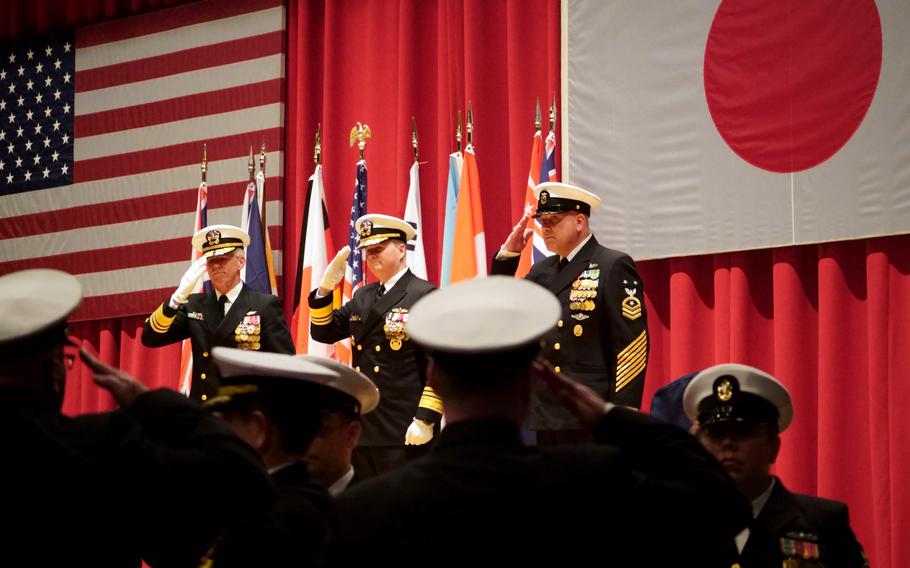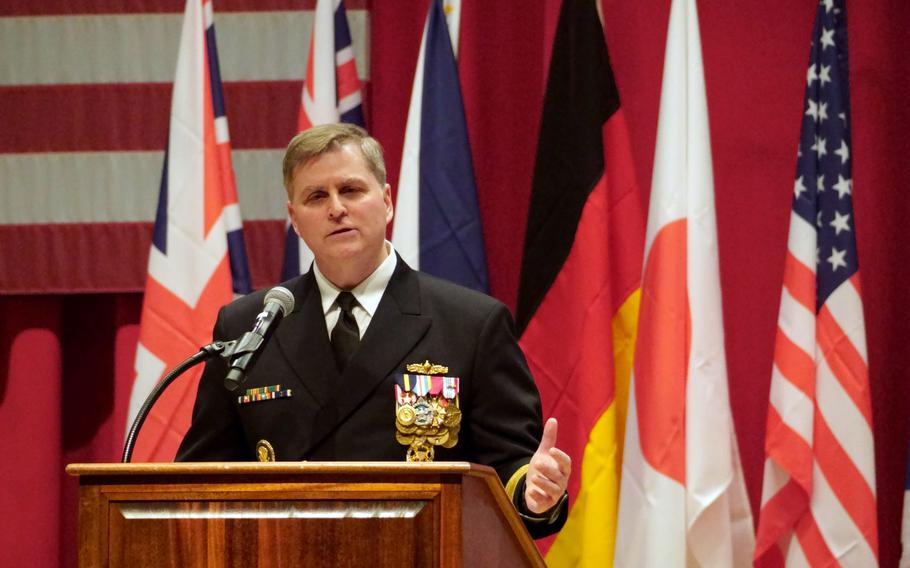
Outgoing 7th Fleet commander Vice Adm. Karl Thomas, left, incoming commander Vice Adm. Fred Kacher and Command Master Chief Petty Officer Daniel Field salute during a change of command ceremony at Yokosuka Naval Base, Japan, Feb. 15, 2024. (Akifumi Ishikawa/Stars and Stripes)
YOKOSUKA NAVAL BASE, Japan — A veteran surface warfare officer took the helm of the U.S. 7th Fleet on Thursday amid a flurry of naval activity in the South China Sea and surrounding areas.
Vice Adm. Fred Kacher took command of the Navy’s largest overseas fleet during a ceremony at Yokosuka’s Fleet Theater. Departing is Vice Adm. Karl Thomas, 7th Fleet’s longest-serving commander, who’s led the Yokosuka-based naval force since July 2021.
Kacher most recently served as acting superintendent for the U.S. Naval Academy in Annapolis, Md., but most of his career has been spent aboard destroyers, cruisers and other warships.
“Suffice it to say, I’m deeply honored to lead what I’ve long believed is one of the most historic and consequential commands in the United States Navy,” Kacher, who was promoted to vice admiral that morning, told the audience.
The 7th Fleet “at any given time” has 50-70 ships and submarines, 150 aircraft and more than 27,000 sailors and Marines, according to its official website.
Its operations area covers more than 48 million square miles, from the International Date Line to the India-Pakistan border, from the Kuril Islands in the north to the Antarctic in the south. About half the world’s population and 36 maritime nations, including China, Russia, India, North and South Korea, fall within that space.

Seventh Fleet's new commander, Vice Adm. Fred Kacher, addresses the Fleet Theater audience during his change-of-command ceremony at Yokosuka Naval Base, Japan, Feb. 15, 2024. (Akifumi Ishikawa/Stars and Stripes)
Thomas will take over as the Navy’s director of naval intelligence, a position that also carries the title of deputy chief of naval operations for information warfare. He was nominated by President Joe Biden for the position in March 2023 and confirmed on Dec. 5, according to congressional records.
Thomas, during Thursday’s ceremony, referenced 7th Fleet’s informal “Fights On!” motto, which he said equates to a mindset of always being ready.
“We are ready, with forward presence, to deter those who wish to disrupt the status quo, and to assure our partners and allies of our commitment to the Indo-Pacific,” he said. “We are ready with, with our best ability, to respond to a humanitarian crisis or search and rescue efforts, and to help those that are in need.”
Under Thomas’ watch, 7th Fleet has steadily grown partnerships between allied navies in the region and, in some cases, expanded its activities.
Dual aircraft carrier drills, for example, were once considered a rarity. They became more commonplace during Thomas’ tenure.
The USS Carl Vinson and USS Theodore Roosevelt in late January held an exercise with a Japanese helicopter destroyer in the Philippine Sea. In November, the USS Ronald Reagan and the Carl Vinson joined up for similar drills.
Those kinds of activities allow the 7th Fleet to be “so prepared and resolute” that it deters “any challenge to the rules-based international order or the status quo,” he said.
In the South China Sea, which China claims as its territorial waters, 7th Fleet ships have repeatedly trained in the past several years alongside allies such as Australia, Japan and the Philippines.
Last week, the littoral combat ship USS Gabrielle Giffords trained alongside a Philippine patrol ship in the region. A day prior, on Feb. 8, the Gabrielle Giffords and the guided-missile destroyer USS John Finn trained with a Japanese destroyer and an Australian frigate.
While Thomas was a career aviator, Kacher brings a different set of skills to the fleet. He previously led the Japan-based Expeditionary Strike Group Seven and served as commander of Destroyer Squadron 7, based in Singapore.
Other posts include executive officer aboard the guided-missile destroyer USS Barry and commander of the guided-missile destroyer USS Stockdale. Off ship, he held such positions as vice director for operations on the Joint Staff and chief of staff for U.S. Pacific Fleet’s Naval Surface Force.